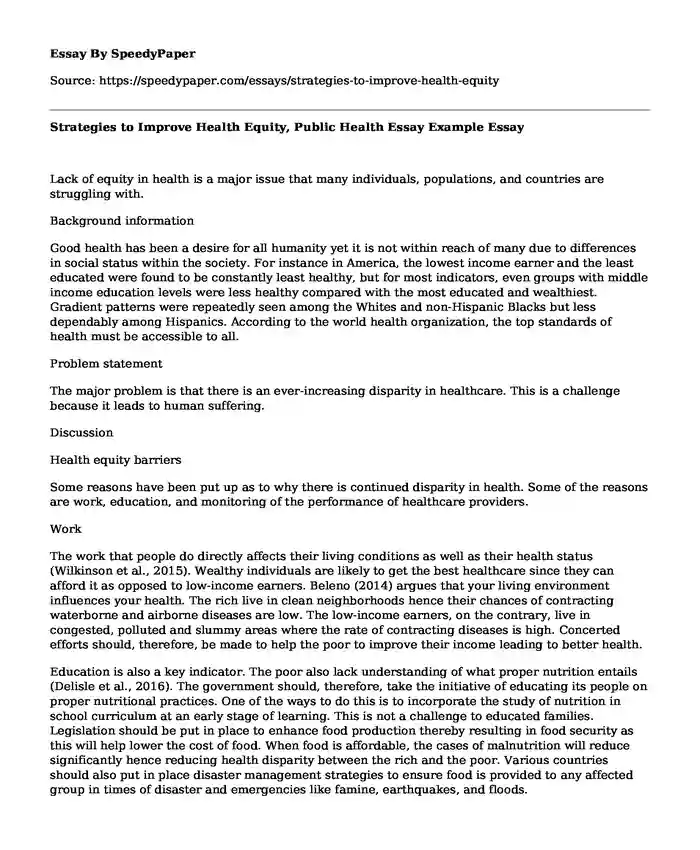
| Type of paper: | Essay |
| Categories: | Public health |
| Pages: | 3 |
| Wordcount: | 757 words |
Lack of equity in health is a major issue that many individuals, populations, and countries are struggling with.
Background information
Good health has been a desire for all humanity yet it is not within reach of many due to differences in social status within the society. For instance in America, the lowest income earner and the least educated were found to be constantly least healthy, but for most indicators, even groups with middle income education levels were less healthy compared with the most educated and wealthiest. Gradient patterns were repeatedly seen among the Whites and non-Hispanic Blacks but less dependably among Hispanics. According to the world health organization, the top standards of health must be accessible to all.
Problem statement
The major problem is that there is an ever-increasing disparity in healthcare. This is a challenge because it leads to human suffering.
Discussion
Health equity barriers
Some reasons have been put up as to why there is continued disparity in health. Some of the reasons are work, education, and monitoring of the performance of healthcare providers.
Work
The work that people do directly affects their living conditions as well as their health status (Wilkinson et al., 2015). Wealthy individuals are likely to get the best healthcare since they can afford it as opposed to low-income earners. Beleno (2014) argues that your living environment influences your health. The rich live in clean neighborhoods hence their chances of contracting waterborne and airborne diseases are low. The low-income earners, on the contrary, live in congested, polluted and slummy areas where the rate of contracting diseases is high. Concerted efforts should, therefore, be made to help the poor to improve their income leading to better health.
Education is also a key indicator. The poor also lack understanding of what proper nutrition entails (Delisle et al., 2016). The government should, therefore, take the initiative of educating its people on proper nutritional practices. One of the ways to do this is to incorporate the study of nutrition in school curriculum at an early stage of learning. This is not a challenge to educated families. Legislation should be put in place to enhance food production thereby resulting in food security as this will help lower the cost of food. When food is affordable, the cases of malnutrition will reduce significantly hence reducing health disparity between the rich and the poor. Various countries should also put in place disaster management strategies to ensure food is provided to any affected group in times of disaster and emergencies like famine, earthquakes, and floods.
Measurement of performance and evaluation of health professionals is also a key component that influences health equity. There should be equity in the distribution of health resources as this will help in achieving the required standards of healthcare provision. When there are adequate resources, the performance of healthcare personnel can be measured without bias. According to Israel (2016), there should be approaches to influencing performance measurement at health facilities and ways to inspire implementation of best practices. Gini et al. (2017) argue that monitoring compliance in healthcare reduces health inequity. Healthcare providers should adopt universally acceptable performance standards as well as checking their implementation in all the healthcare facilities. There should be clear indicators to the performance standards to enable their measurement as their universal implementation will reduce disparity in healthcare.
Conclusion
In order to understand the disparities in health, there should be a collaboration between the government, the world health organization, educational institutions and general populations to research with the aim of achieving health equity.
References
Beleno, C. (2014). About challenges of the modern world: Health, environment and social development America Latina case. Megatrend revija, 11(3), 135-144. doi:10.5937/megrev1403135b
Delisle, H., Shrimpton, R., Blaney, S., Du Plessis, L., Atwood, S., Sanders, D., & Margetts, B. (2016). Capacity-building for a strong public health nutrition workforce in low-resource countries. Bulletin of the World Health Organization, 95(5), 385-388. doi:10.2471/blt.16.174912
Gini, R., Schuemie, M. J., Pasqua, A., Carlini, E., Profili, F., Cricelli, I., ... Klazinga, N. (2017). Monitoring compliance with standards of care for chronic diseases using healthcare administrative databases in Italy: Strengths and limitations. PLOS ONE, 12(12), e0188377. doi:10.1371/journal.pone.0188377
Israel, S. (2016). How social policies can improve financial accessibility of healthcare: a multi-level analysis of unmet medical need in European countries. International Journal for Equity in Health, 15(1). doi:10.1186/s12939-016-0335-7
Wilkinson, G. W., Sager, A., Selig, S., Antonelli, R., Morton, S., Hirsch, G., ... Wachman, M. (2017). No Equity, No Triple Aim: Strategic Proposals to Advance Health Equity in a Volatile Policy Environment. American Journal of Public Health, 107(S3), S223-S228. doi:10.2105/ajph.2017.304000
Cite this page
Strategies to Improve Health Equity, Public Health Essay Example. (2022, Feb 28). Retrieved from https://speedypaper.net/essays/strategies-to-improve-health-equity
Request Removal
If you are the original author of this essay and no longer wish to have it published on the SpeedyPaper website, please click below to request its removal:
- Free Essay on the Role of Theological Research
- When One Has Lived a Long Time Alone - Poetry Analysis Essay Sample
- Boyz n the Hood vs. the Breakfast Club - Movie Review Essay Sample
- Personal Essay Example for Apply Graduate School
- Date Trump Immigration Ban
- Essay Example: Immigration and Undocumented Workers
- Individual's History - Free Essay Example
Popular categories




